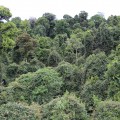Big trees three or more feet in diameter accounted for nearly half the biomass measured at a Yosemite National Park site, yet represented only one percent of the trees growing there.
This means just a few towering white fir, sugar pine and incense cedars per acre at the Yosemite site are disproportionately responsible for photosynthesis, converting carbon dioxide into plant tissue and sequestering that carbon in the forest, sometimes for centuries, according to James Lutz, a University of Washington research scientist in environmental and forest sciences. Lutz is lead author of a paper on the largest quantitative study yet of the importance of big trees in temperate forests being published online May 2 on PLoS ONE. The research was funded by the Smithsonian Center for Tropical Forest Science.

A handful of large-diameter trees per acre, such as these incense cedars, together with remains of big trees like the three-foot-wide white fir snag and downed debris account for half the forest biomass at a Yosemite National park study site. (Image by James Lutz)
“In a forest comprised of younger trees that are generally the same age, if you lose one percent of the trees, you lose one percent of the biomass,” he says. “In a forest with large trees like the one we studied, if you lose one percent of the trees, you could lose half the biomass.”
In 2009, scientists including Lutz reported that the density of large-diameter trees declined nearly 25 percent between the 1930s and 1990s in Yosemite National Park, even though the area was never logged. Scientists have found notable numbers of large trees dying in similar areas across the West.

Washington State University’s Mark Swanson pulls a tape tight around a 4-foot-wide sugar pine, one of the 34,500 live trees counted and tagged for long-term study in a Yosemite National Park study plot. (Washington State University)
The new 63-acre study site is one of the largest, fully-mapped plots in the world and the largest old-growth plot in North America. The tally of what’s there, including the counting and tagging of 34,500 live trees, was done by citizen scientists. The site is part of the network of the Smithsonian Center for Tropical Forest Science, a global network of 42 tropical and temperate forest plots including the one in Yosemite.
One implication of the research is that land managers may want to pay more attention to existing big trees, the co-authors said. In some younger forests that lack big trees, citizens and land managers might want to consider fostering the growth of a few big-trunked trees, Lutz added.
—Source: University of Washington.





